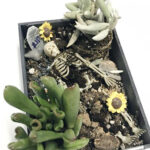Spooky Succulent Garden
by Ana Morlier
Happy October, everyone! Looks like it’s time to put down the pumpkin-spiced lattes and pull out your next great costume. The season of free candy, spooks, and transforming into your favorite character is upon us!
Halloween is drawing closer and closer, with its anticipation following close behind. Even though the status of trick-or-treating may be uncertain, there is one fun activity that we can all take part in: decorating!
Jack-o-lanterns, ghosts, and talking animatronics seem to be standard decor these days. It seems difficult to make a statement when pretty much everyone has a talking head on their lawn. It’s also difficult to stay family-friendly. Having your favorite horror movie characters seemingly alive on your lawn sounds great in theory. However, it’s not as fun when you have a dozen laughing clowns scaring your trick-or-treaters away (with angry parents in tow). Likewise, just when you have admired your work of angling your projector just right, you have to change out your decorations for cornucopias. October seems to come and go so quickly!
Luckily for you, reader of the Banner, I have come upon a decoration that is sustainable, family-friendly, and spooky!
Here’s a list of what you will need for your Spooky Succulent Garden:
Small wooden coffin box or a rectangular wooden box (preferably, small; can be found at the Dollar Store. You may need to paint your coffin!);
Your favorite succulents [Try these to set a spooky mood: Black Hens and Chicks, Black Zebra Cactus (Haworthia), Chocolate drop stonecrop, Zwartkop, Arachnacantha, Black Knight, Black rose, and Living Stones];
A mini skeleton (or one to fit your coffin. You can also hot-glue dried pasta together to form a convincing skeleton);
Potting Soil;
Cardboard or paper;
Hot glue gun or duct tape;
Your favorite Halloween music (Thriller, anyone?).
Step 1
Paint your coffin, if desired. Fill your coffin about three-quarters of the way full, leaving room for your succulents.
Step 2
Lay your succulents to rest (in the coffin)! Position your plants however you want, just keep in mind that you will need to put your skeleton in the coffin, preferably unobstructed. Try to place a small to medium-sized succulent near the head of the coffin. You can also add a visitor by adding googly-eyes to an Old Man Cactus and planting it off to the side.
Step 3
Slightly bury your skeleton in the dirt. Cut out your paper/cardboard to look like a mini tombstone. For ease in placement, tape or glue your (colored) piece of paper to the cardboard shape, as this will also act as a better garden stake. Make sure you cut your cardboard longer than the piece of paper so that your tombstone stays deep in the dirt.
Step 4
Add whatever you wish to your spooky scene! Some ideas include air plants as your skeleton’s hair, integrating living stones as stepping stones (or other pebbles), or adding another skeleton (Do I see an arm-wrestling match in the near future?).
You can use the skeleton idea on a larger scale. A skeleton waving at guests from your garden will provide quite a bit of surprise. If you properly seal a skull or adhere it to a flowerpot, you have an eerie planter!
While your coffin planter may seem puny in comparison to your neighbor’s life-sized werewolf animatronic, it will startle your next party guest and stay around all year-round. With flowers out of season, this decoration will make a chilling, yet festive, centerpiece for your table.
May all your plants protect you this Halloween!


